Can Baby Clothes Be Tumble Dried? Expert Guide to Safe Temperature Settings, Fabric Care & Energy Tips
When caring for a new baby, laundry becomes a constant part of daily life. Most baby clothes can be tumble dried safely, but always check the care label first to avoid shrinking or damaging delicate fabrics. Small details like snaps, buttons, or decorative elements sometimes require gentler settings or air drying to maintain their quality.
Finding the right balance between convenience and care helps keep baby clothes soft, safe, and ready to wear. This comprehensive guide covers everything parents need to know about drying baby clothes safely and efficiently.
Table of Contents
Key Takeaways
- Many baby clothes are safe for tumble drying with proper care and settings
- Always read care labels and adjust settings for different fabric types
- Gentle drying methods help baby clothes last longer and stay comfortable
- Flame retardant considerations are important for children’s sleepwear
- Energy-efficient practices can save money while protecting clothes
Understanding Tumble Drying for Baby Clothes
Tumble drying can be a lifesaver for parents who need clothes ready quickly, especially during bad weather or when dealing with multiple outfit changes per day. Understanding how the process works helps make better decisions for baby laundry.
What Is Tumble Drying
Tumble drying uses a machine to dry clothes by circulating hot air while spinning the laundry inside a drum. This process removes moisture much faster than air drying, making it particularly helpful when space is limited or weather conditions prevent outdoor drying.
Most tumble dryers offer various cycle options including gentle, normal, and timed dry settings. Baby clothes typically need a gentle or low-heat setting to prevent shrinking or damage to delicate cotton fabrics and other materials.
Understanding the basic principles of tumble drying helps parents make informed decisions about their baby’s clothes.
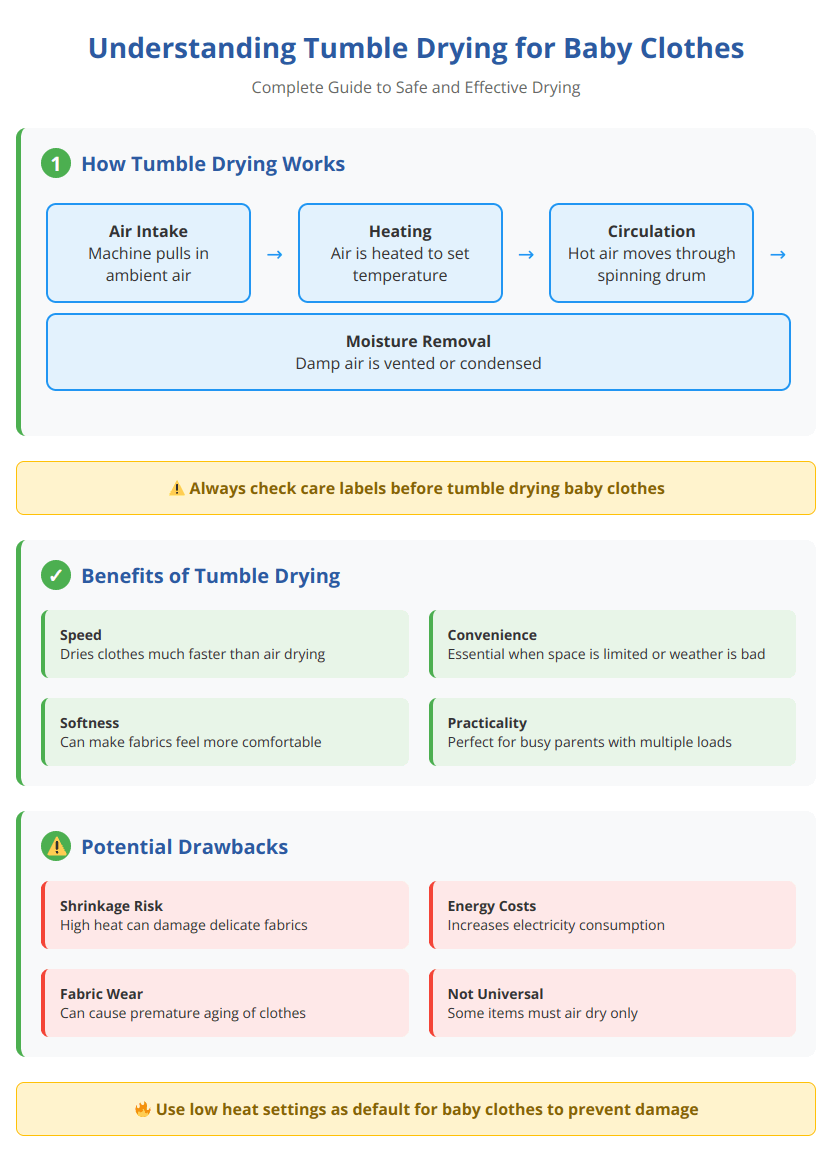
These fundamentals provide the foundation for safe and effective baby clothes drying practices.
Care labels on baby clothes indicate whether tumble drying is safe, and checking these before starting any load is essential.
How Tumble Dryers Work
Tumble dryers pull in ambient air, heat it, and push it through a spinning drum containing the clothes. The drum’s movement helps separate items so hot air can circulate evenly and dry clothes thoroughly.
The warm, moist air is then either vented outside or collected as water, depending on the dryer type. Condenser dryers collect water in a removable tray, while vented dryers expel hot air through an external vent.
Modern dryers include settings for temperature and drying time. For baby clothes, gentle or delicate cycles work best. These reduce wear on soft fabrics and limit shrinkage. Many newer dryers have moisture sensors that automatically stop drying when clothes reach the right moisture level, helping save energy and protect clothing.
Benefits and Drawbacks of Tumble Dryers
Benefits:
- Dries clothes much faster than air drying
- Essential when space is limited or weather prevents outdoor drying
- Can soften fabrics, making clothes feel more comfortable
- Convenient for busy parents managing multiple loads daily
Tumble drying becomes particularly valuable when managing the constant laundry that comes with newborns and toddlers.
Drawbacks:
- Some fabrics may shrink or become damaged with high heat
- Increases energy consumption and utility costs
- Not all baby clothes are dryer-safe; some must air dry to maintain their shape and quality
- Can cause premature wear on elastic components
Reading care labels and using the lowest safe heat setting helps avoid damage to delicate items or anything labeled “do not tumble dry.”
Fabric Considerations for Baby Garments
When selecting and caring for baby clothing, fabric type plays a crucial role in determining the best drying method. Different materials respond differently to heat and mechanical action.
Different fabric types require specific care approaches to maintain their quality and safety for baby’s sensitive skin.

Following fabric-specific guidelines ensures baby clothes remain comfortable and durable through many washes.
Material Types Best Suited for Machine Drying
Cotton remains the most common fabric in baby clothes like onesies and sleepers. 100% cotton can usually handle tumble drying on low heat settings, though it may shrink slightly after the first wash and dry cycle.
Cotton blends, particularly cotton mixed with polyester, tend to resist shrinking better and maintain their shape more consistently. These blends dry faster and typically wrinkle less than pure cotton options.
Bamboo fabrics are becoming increasingly popular for baby clothing. While bamboo is highly absorbent and naturally antibacterial, the fibers may weaken with repeated high-heat drying. Using low temperatures helps protect the softness and durability of bamboo garments.
For items like baby socks and basic garments, gentle cycles with low heat work well to maintain elastic bands’ stretchiness and prevent fabric roughness.
Fabric Compatibility Quick Reference:
| Fabric Type | Tumble Dry Safe? | Recommended Heat Setting | Special Notes |
|---|---|---|---|
| 100% Cotton | Yes, with care | Low | May shrink slightly on first wash |
| Cotton-Poly Blend | Yes | Low to Medium | Most durable option |
| Bamboo Viscose | Yes, with caution | Low only | Weakens with high heat |
| Polyester | Yes | Low to Medium | Inherently quick-drying |
| Organic Cotton | Yes, with care | Low | Premium option, gentle care needed |
Delicate Fabrics and Special Care
Some baby clothes feature lace, silk, wool, or decorative prints that require special attention. These materials should not go in a tumble dryer because they may shrink, snag, or become damaged.
Wool items, unless specifically labeled as machine-washable and dryable, can shrink dramatically in the dryer. Laying these items flat to dry works best, especially for knit hats or delicate sweaters.
Silk garments or clothes with fine decorations should always air-dry, as heat can damage their fibers and cause colors to fade or run.
Items with a “Do Not Tumble Dry” label should be avoided in the dryer completely. This extra care keeps baby clothes soft and in good condition for longer periods, which is especially important for hand-me-downs that may be passed between children.
Safety Standards and Flame Retardant Considerations
Understanding safety requirements for children’s clothing, particularly sleepwear, is crucial for making informed drying decisions.
Federal safety requirements for children’s sleepwear directly impact how these items should be dried and cared for.
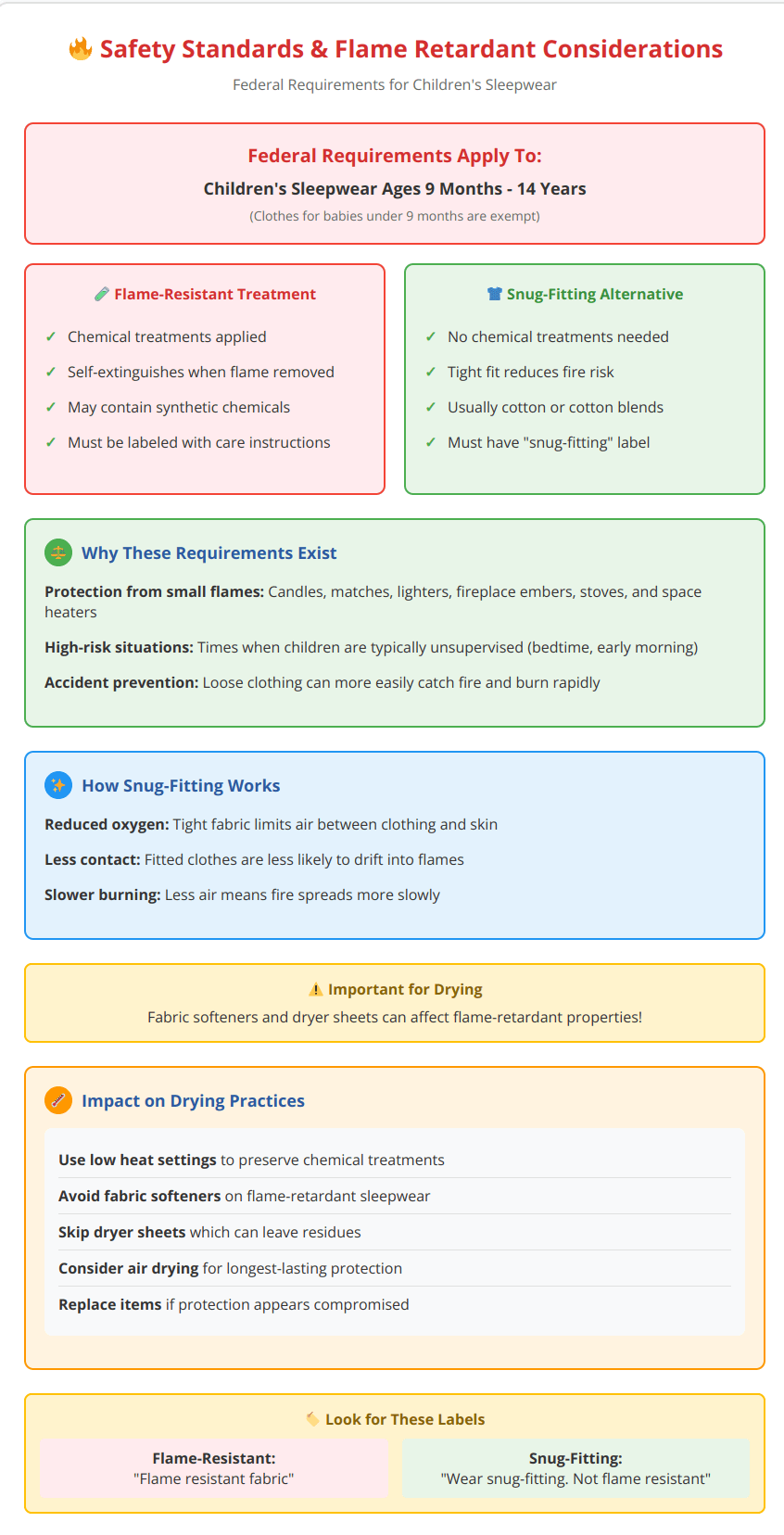
Understanding these regulations helps parents choose appropriate sleepwear and care methods that maintain safety standards.
Understanding Flame Retardant Requirements
Federal regulations require children’s sleepwear for ages 9 months to 14 years to be either flame-resistant or snug-fitting. This requirement exists because loose clothing can more easily catch fire from small flames like candles, matches, or fireplaces.
Why This Matters for Drying:
- Fabric softeners and dryer sheets can affect the flame-retardant properties of treated sleepwear
- Chemical flame retardants may break down with repeated high-heat drying
- Understanding which clothes have treatments helps determine appropriate care
Chemical-Free Alternatives
Many parents prefer to avoid chemical flame retardants due to health concerns. Snug-fitting pajamas provide a safer alternative because:
- Tight fabric reduces the oxygen that fires need to spread
- No chemical treatments are required
- Clothes remain safe through proper fit rather than chemical additives
How to Identify Safe Options:
- Look for labels saying “snug-fitting” and “not flame resistant”
- Avoid items labeled “flame resistant” if trying to minimize chemical exposure
- Check that sleepwear fits properly according to size charts
Impact on Drying Practices
When drying flame-retardant sleepwear:
- Use low heat settings to preserve chemical treatments
- Avoid fabric softeners and dryer sheets
- Consider air drying for longest-lasting flame resistance
- Replace items if flame-resistant properties appear compromised
For more information about children’s clothing safety, parents should stay informed about current regulations and recommendations.
Embellishments and Fasteners: Special Considerations
Baby clothes often feature decorative elements that need extra care during the drying process.
Decorative elements on baby clothes need special consideration during the drying process to prevent damage.
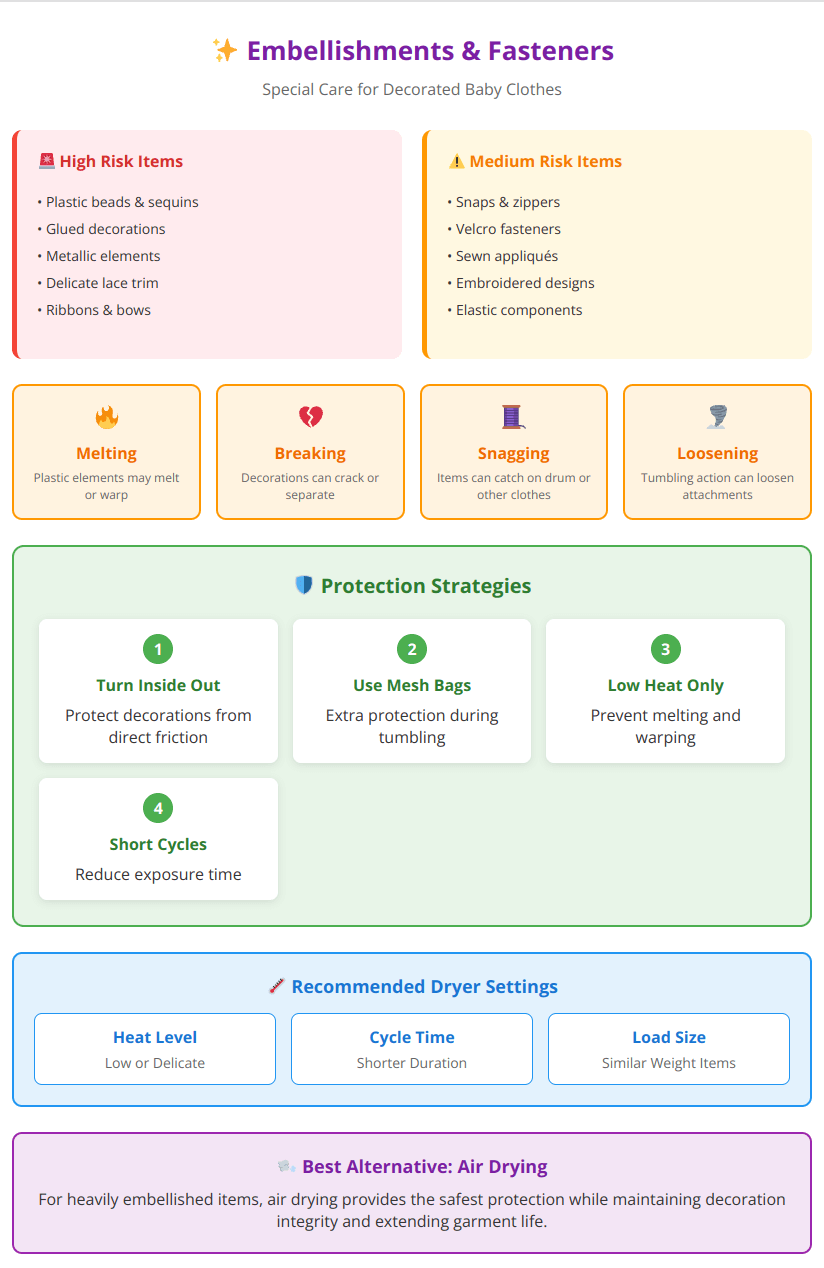
Taking extra care with embellished items preserves their appearance and extends their usable life.
Impact of Tumble Drying on Embellishments
Heat and friction during tumble drying can damage decorative elements. Plastic beads, sequins, or appliqués may melt, crack, or become loose when exposed to high temperatures. Sewn-on items like ribbons, lace trim, or decorative patches can snag or separate during the tumbling action.
Common Issues:
- Fasteners like snaps, zippers, and Velcro may warp or break
- Loose threads around embellishments can worsen with tumbling
- Glued decorations may separate from fabric
- Metallic elements can become tarnished or discolored
Protecting Embellished Baby Clothes
To keep decorated items safe during drying:
Pre-Drying Steps:
- Turn clothes inside out to reduce direct friction on decorations
- Use mesh laundry bags for extra protection during tumbling
- Check all decorative elements for loose pieces before drying
Dryer Settings:
- Select low heat or delicate settings exclusively
- Avoid high heat settings that can melt plastic components
- Use shorter drying cycles and check progress frequently
Alternative Methods:
- Air dry heavily embellished items when possible
- Lay flat items with extensive decorations
- Remove items while slightly damp to prevent overheating
For special occasion outfits or heirloom baby clothes, air drying often provides the best protection for maintaining their appearance and value.
Temperature Settings and Best Practices
Choosing the right temperature settings protects baby clothes while ensuring they dry thoroughly and safely.
Choosing the right temperature setting is crucial for protecting baby clothes from heat damage while ensuring thorough drying.
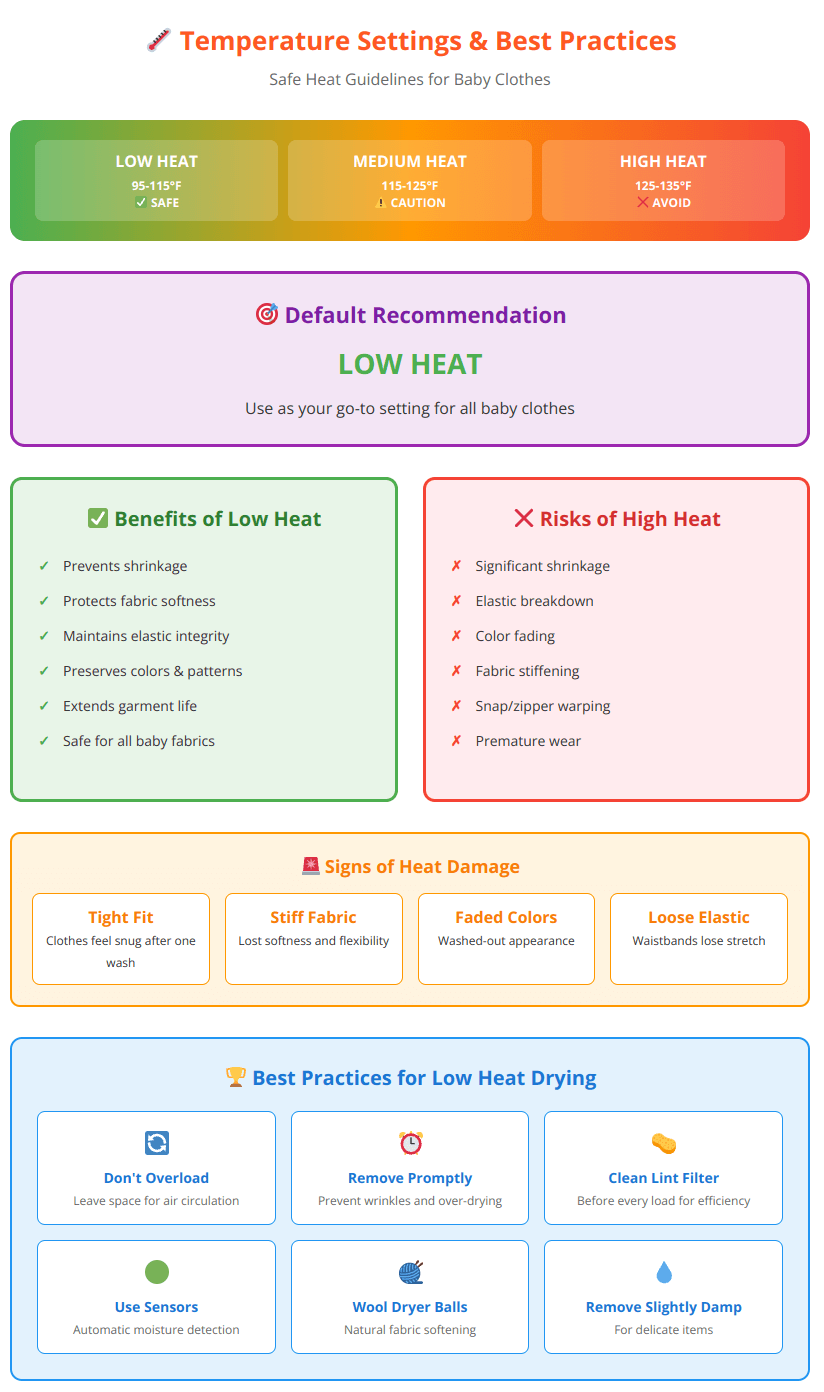
Consistently using appropriate temperature settings prevents shrinkage and extends clothing life significantly.
When to Use Tumble Dry Low
Low heat settings work best for most baby clothes, especially those made from cotton, muslin, or blended fabrics. This gentle approach prevents shrinking while protecting soft textures that babies’ sensitive skin requires.
Items Perfect for Low Heat:
- Cotton onesies and bodysuits
- Soft sleepers and pajamas
- Baby socks and basic garments
- Swaddle blankets and receiving blankets
- Most everyday baby clothing
Benefits of Low Heat Drying:
- Reduces shrinkage risk significantly
- Maintains fabric softness longer
- Protects elastic components in waistbands and leg openings
- Preserves colors and patterns better
- Prevents damage to snaps and zippers
Low Heat Drying Tips:
- Avoid overloading the dryer for even heat distribution
- Remove clothes promptly to prevent wrinkles
- Use moisture sensors when available to prevent over-drying
- Consider using wool dryer balls to improve air circulation
Risks of High Heat and Hot Water
High heat settings increase the risk of shrinking baby clothes and can cause elastic components to lose their stretch. Colors may fade more quickly, and printed designs can crack or peel with repeated exposure to high temperatures.
Problems Caused by High Heat:
- Significant shrinkage, especially in natural fibers
- Elastic breakdown in leg holes, waistbands, and sleeve cuffs
- Color fading and pattern deterioration
- Weakening of fabric fibers over time
- Potential damage to waterproof coatings on items like bibs
Hot Water Impact: While hot water kills more germs, it can cause similar problems during washing. Cold or warm water combined with proper detergent usually provides adequate cleaning for baby clothes while protecting fabric integrity.
Signs of Heat Damage:
- Clothes feel snug after one wash and dry cycle
- Elastic components lose stretch
- Colors appear faded or washed out
- Fabric feels rough or stiff
Maintaining low heat settings and gentle handling helps baby clothes last longer and stay comfortable for growing children.
Energy Efficiency and Cost Savings
Making smart choices about drying baby clothes can significantly reduce energy costs while maintaining clothing quality.
Smart energy choices during baby clothes drying can significantly reduce household costs while maintaining clothing quality.
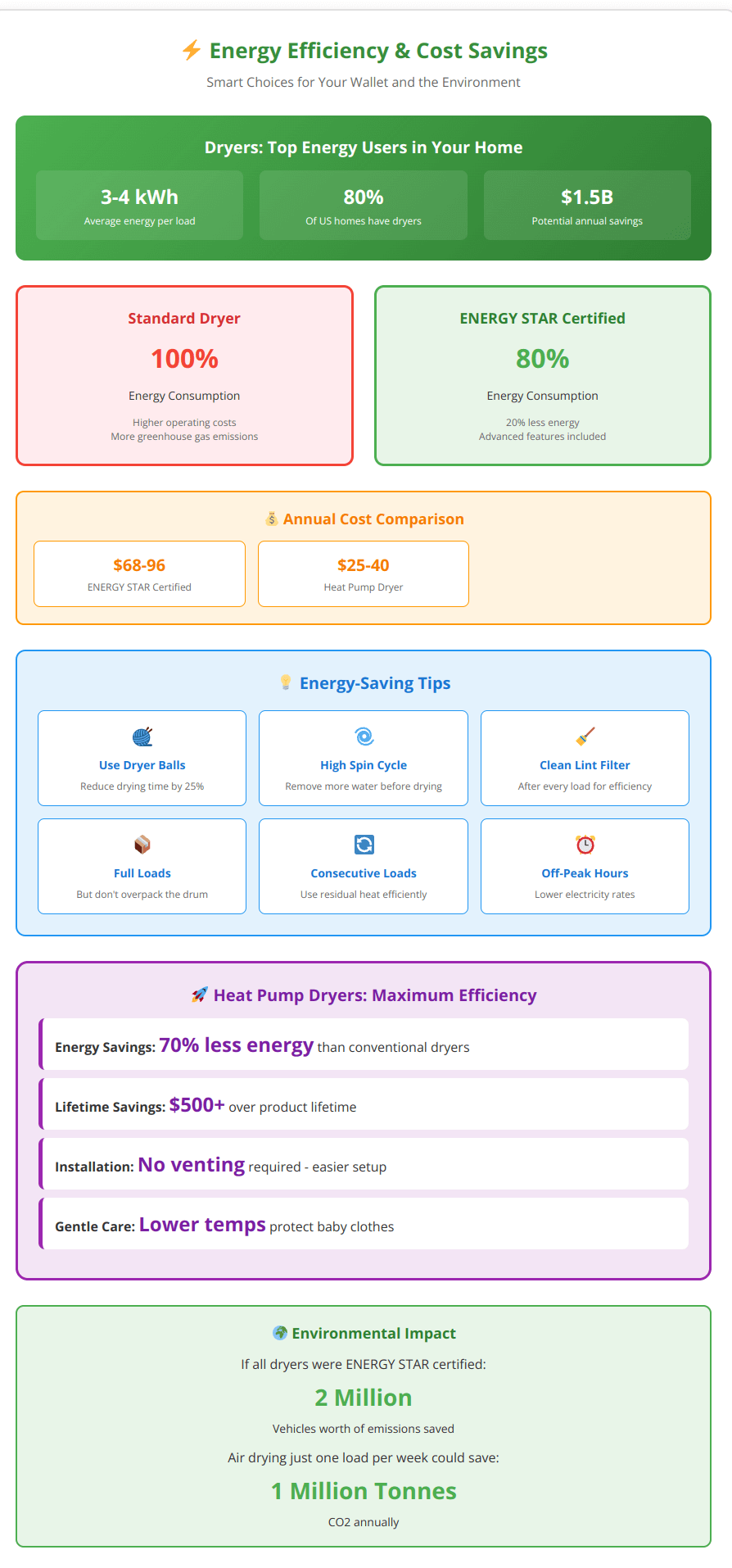
Implementing these energy-efficient practices benefits both your budget and the environment long-term.
Understanding Energy Consumption
Dryers rank among the top energy-using appliances in most homes. An average electric dryer uses 3-4 kilowatt-hours (kWh) per load, which can add up quickly with the frequent washing babies require.
Energy-Saving Strategies:
- Use wool dryer balls – These reduce drying time by improving air circulation and absorbing moisture naturally
- Optimize load sizes – Full loads use energy more efficiently than multiple small loads
- Clean lint filters – Remove lint after every load to improve airflow and reduce drying time
- Use highest spin cycle on washer – Extract more moisture before drying to reduce dryer time needed
ENERGY STAR and Efficient Models
ENERGY STAR certified dryers use approximately 20% less energy than standard models and incorporate advanced features like automatic moisture sensors. According to the EPA, if all clothes dryers sold in the U.S. were ENERGY STAR certified, Americans could save more than $1.5 billion annually in utility costs and prevent greenhouse gas emissions equivalent to those from more than 2 million vehicles.
Advanced Features:
- Moisture sensors that automatically stop when clothes are dry
- Multiple heat settings for different fabric types
- Energy-efficient heat pump technology (uses up to 70% less energy)
- Smart controls that optimize cycles based on load type
Heat Pump Dryers:
- Most energy-efficient option available
- Use ambient air temperature rather than electric heating elements
- Cost more initially but provide significant long-term savings
- Take longer to dry but use much less energy
Cost-Effective Drying Practices
Timing Strategies:
- Dry multiple loads consecutively to use residual heat
- Take advantage of off-peak electricity rates when available
- Combine similar fabric weights for more efficient drying
Maintenance for Efficiency:
- Clean dryer vents annually to maintain proper airflow
- Check and clean moisture sensors monthly
- Ensure proper installation with shortest possible vent route
Alternative Methods:
- Line dry when weather permits for zero energy cost
- Use indoor drying racks during winter months
- Air dry delicate items to extend their life
These practices not only save money but also reduce environmental impact while keeping baby clothes in excellent condition.
Alternative Drying Methods for Baby Clothes
Understanding various drying options helps parents choose the best method for different situations and fabric types.
Air drying and alternative methods offer gentle, energy-free options for caring for baby’s delicate clothing.
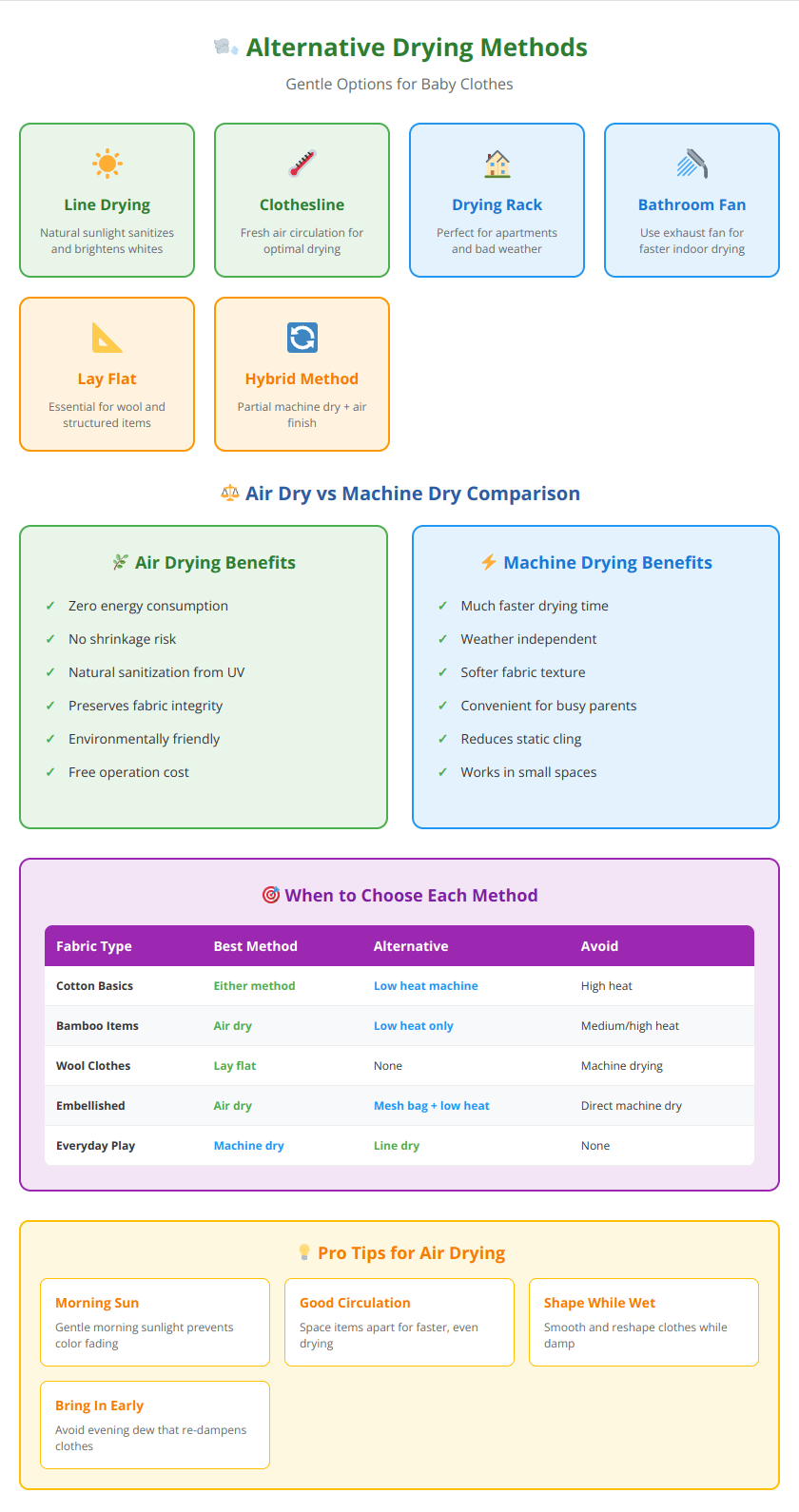
Choosing the right drying method depends on fabric type, weather conditions, and family priorities.
Benefits of Line Drying and Hang Drying
Air drying offers several advantages for baby clothing care. The gentle process maintains fabric integrity while providing natural sanitization benefits.
Natural Sanitization:
- Sunlight acts as a natural disinfectant, killing germs and bacteria
- UV rays help remove stains and brighten white fabrics
- Fresh air eliminates odors without chemical additives
Fabric Protection:
- No heat exposure prevents shrinkage and fiber damage
- Maintains elasticity in waistbands and leg openings
- Preserves fabric softness and texture
- Protects decorative elements and embellishments
Environmental Benefits:
- Zero energy consumption reduces carbon footprint
- No electricity costs for drying
- Reduces wear on dryer, extending its lifespan
Choosing the Right Drying Method
The best drying approach depends on several factors including fabric type, weather conditions, available space, and time constraints.
Decision Matrix:
| Fabric Type | Best Method | Backup Option | Special Notes |
|---|---|---|---|
| Cotton basics | Line dry or low heat | Either method works | Most versatile option |
| Bamboo clothing | Air dry preferred | Low heat if needed | Heat weakens fibers |
| Wool items | Lay flat only | Never machine dry | Prevents stretching |
| Embellished clothes | Air dry only | Gentle cycle if urgent | Protects decorations |
| Waterproof items | Air dry | Low heat, short cycle | Heat damages coatings |
Indoor Drying Options:
- Drying racks near heating vents for faster drying
- Bathroom exhaust fans to remove humidity
- Dehumidifiers to speed indoor air drying
- Shower rods for hanging delicate items
Outdoor Considerations:
- Morning sun provides gentle drying without overheating
- Avoid direct afternoon sun which can fade colors
- Bring clothes in before evening dew settles
- Use clothespins that won’t leave marks on delicate fabrics
For apartments or homes without outdoor space, indoor air drying remains an effective option that protects clothes while saving energy costs.
Stain Removal and Pre-Drying Preparation
Proper stain treatment before drying ensures baby clothes stay clean and stains don’t become permanent.
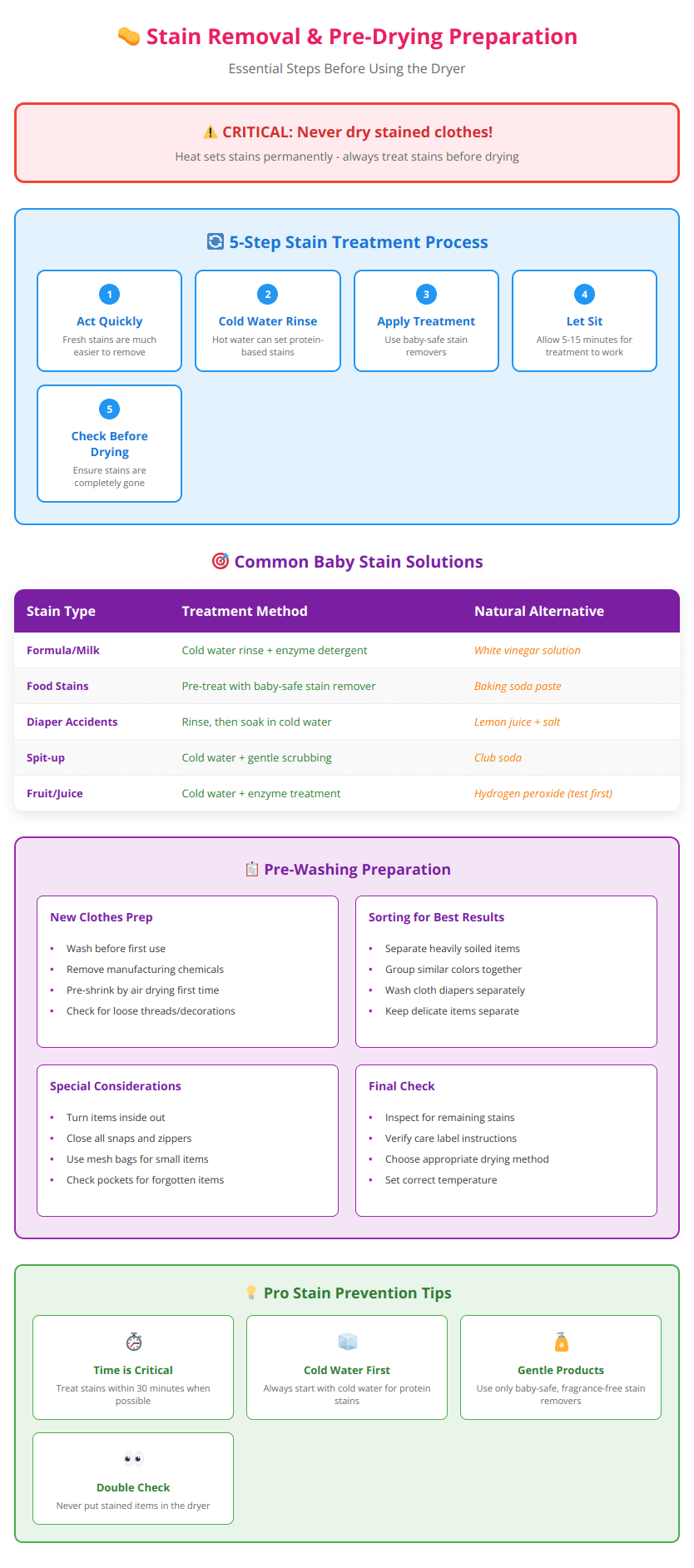
Following these preparation steps ensures clothes come out clean and stain-free after drying.
Effective Stain Treatment Before Drying
Always treat stains before putting clothes in the dryer, as heat can set stains permanently. Different types of stains require specific approaches for best results.
General Stain Treatment Steps:
- Act quickly – Fresh stains are much easier to remove than set-in stains
- Rinse with cold water – Hot water can set protein-based stains like formula or food
- Apply appropriate treatment – Use baby-safe stain removers or natural alternatives
- Let treatment sit – Allow 5-15 minutes for treatment to work before washing
- Check before drying – Ensure stains are completely gone before heat drying
Common Baby Stains and Solutions:
| Stain Type | Treatment Method | Natural Alternative |
|---|---|---|
| Formula/Milk | Cold water rinse, enzyme detergent | White vinegar solution |
| Food stains | Pre-treat with baby-safe stain remover | Baking soda paste |
| Diaper accidents | Rinse, then soak in cold water | Lemon juice and salt |
| Spit-up | Cold water, gentle scrubbing | Club soda |
| Fruit/juice | Cold water, enzyme treatment | Hydrogen peroxide (test first) |
Pre-Washing Considerations
New Clothes Preparation:
- Always wash baby clothes before first use to remove manufacturing chemicals
- Pre-shrink items by washing in warm water and air drying first wear
- Check for loose threads or decorations that might come off in washing
Sorting for Best Results:
- Separate heavily soiled items from lightly soiled ones
- Group similar colors to prevent bleeding
- Wash cloth diapers separately from regular clothes
- Keep delicate items separate from heavier fabrics
Special Considerations:
- Turn items inside out to protect prints and decorations
- Close all snaps and zippers to prevent snagging
- Use mesh bags for small items like socks and mittens
- Check pockets for forgotten items that could cause damage
Comprehensive FAQ: Baby Clothes Drying
Is it okay to dry baby clothes in the dryer?
Yes, most baby clothes can be safely dried in a tumble dryer. The key is using appropriate settings and checking care labels first. Use low heat settings and gentle cycles to prevent shrinkage and protect delicate fabrics. Avoid high heat which can damage elastic components and cause excessive shrinkage.
What setting should I dry baby clothes on?
Use the lowest heat setting available, typically labeled as “low,” “delicate,” or “gentle.” Many modern dryers have specific “baby care” settings designed for delicate items. Always check the care label for specific instructions, and when in doubt, err on the side of caution with lower heat.
Can you use tumble dryer sheets on baby clothes?
It’s best to avoid dryer sheets for baby clothes, especially sleepwear. Dryer sheets contain chemicals that can irritate sensitive baby skin and may affect flame-retardant properties in treated sleepwear. Use wool dryer balls instead to reduce static and soften clothes naturally.
Which clothes cannot be tumble dried?
Several types of baby clothes should not go in the dryer:
• Items labeled “Do Not Tumble Dry”
• Wool garments (unless specifically labeled as dryer-safe)
• Heavily embellished clothes with sequins or delicate decorations
• Silk items
• Clothes with waterproof coatings
• Items with special flame-retardant treatments (check label recommendations)
Why shouldn’t you tumble dry baby clothes?
Some concerns about tumble drying include:
• Risk of shrinkage, especially with 100% cotton items
• Potential damage to elastic components
• Wear on delicate fabrics and decorations
• Energy consumption and associated costs
• Possible reduction in flame-retardant effectiveness for treated sleepwear
However, these risks can be minimized with proper settings and care.
How to tumble dry baby clothes safely?
Follow these steps for safe tumble drying:
1. Check care labels for specific instructions
2. Use low heat or delicate settings
3. Avoid overloading the dryer
4. Remove clothes promptly when dry
5. Clean lint filter before each load
6. Use wool dryer balls instead of chemical dryer sheets
7. Turn embellished items inside out for protection
Can you tumble dry baby muslins?
Yes, baby muslins can typically be tumble dried on low heat settings. Muslin becomes softer with each wash and dry cycle. However, check the care label first, as some manufacturers recommend air drying to maintain the fabric’s longevity and softness.
What is baby protect on a tumble dryer?
“Baby Protect” or similar settings on tumble dryers are specialized cycles designed for delicate baby items. These settings typically use:
• Lower temperatures
• Gentler tumbling action
• Moisture sensors to prevent over-drying
• Longer cooling periods
• Reduced wrinkle formation
How to make baby clothes smell good?
To keep baby clothes smelling fresh:
• Use fragrance-free, baby-specific detergents
• Add white vinegar to the rinse cycle as a natural deodorizer
• Ensure clothes are completely dry before storing
• Air dry in sunlight when possible for natural freshening
• Use wool dryer balls with a drop of baby-safe essential oil
• Store clean clothes in breathable containers
How to unshrink baby clothes?
If baby clothes have shrunk:
1. Soak in lukewarm water with baby shampoo for 30 minutes
2. Gently stretch the fabric while wet
3. Lay flat on a towel and reshape carefully
4. Air dry completely before checking fit
5. Steam gently with a handheld steamer if needed
Note: Severe shrinkage may be permanent, especially in 100% cotton items.
Why do all clothes say not to tumble dry?
Many manufacturers use “Do Not Tumble Dry” labels as a precaution to:
• Avoid liability for shrinkage complaints
• Ensure longest possible garment life
• Protect special finishes or treatments
• Account for varying dryer types and user practices
This doesn’t always mean the item will be damaged by careful low-heat drying.
Do tumble dryers ruin elastic?
High heat can damage elastic components, causing them to lose stretch and become brittle. However, using low heat settings and avoiding over-drying helps preserve elastic in:
• Waistbands
• Leg openings
• Sleeve cuffs
• Sock tops
For best results, remove items with elastic while slightly damp and let them finish air drying.
How do I know if I can tumble dry something?
Check these indicators:
• Care label symbols – Look for square with circle (tumble dry) vs. crossed-out symbol (do not tumble dry)
• Fabric content – Natural fibers need more caution than synthetic blends
• Construction – Heavily embellished or structured items often need air drying
• Value – Expensive or sentimental items may warrant air drying regardless of label
What is the alternative to tumble drying?
Several alternatives exist:
• Line drying outdoors for natural sanitization and zero energy cost
• Indoor drying racks for weather-protected drying
• Flat drying for delicate or wool items
• Hanging in bathrooms with exhaust fans for faster indoor drying
• Combination approach – partial machine drying followed by air drying
Is delicate considered tumble dry?
“Delicate” typically refers to a gentle tumble dry cycle with low heat and reduced tumbling action. However, some very delicate items may still require air drying only. Always check the specific care label instructions rather than assuming delicate items can be machine dried.
Is it better to air dry baby clothes or use the dryer?
Both methods have advantages:
Air Drying Benefits:
• No shrinkage risk
• Zero energy cost
• Natural sanitization from sunlight
• Gentlest on all fabrics
Dryer Benefits:
• Much faster drying time
• Softer fabric texture
• Convenient in bad weather
• Practical for frequent washing
The best choice depends on time constraints, weather, fabric type, and personal priorities.
The American Academy of Pediatrics emphasizes keeping loose blankets and soft items out of infant sleep spaces. For warmth, parents should add layers of clothing or use wearable blankets instead of loose bedding, making properly dried and fitted sleepwear even more important for infant safety.
Can you tumble dry baby towels?
Yes, baby towels can typically be tumble dried and often benefit from it. Machine drying helps maintain the fluffy texture that makes towels absorbent. Use medium heat for cotton towels and low heat for bamboo or other delicate materials. Clean the lint filter thoroughly as towels produce significant lint.
Can 100% cotton go in the dryer?
Yes, 100% cotton can go in the dryer, but expect some shrinkage, especially on the first drying cycle. To minimize shrinkage:
• Use low heat settings
• Remove while slightly damp
• Consider air drying for first wash to pre-shrink before machine drying
• Buy items slightly larger to account for shrinkage
Energy Efficiency and Environmental Impact
Understanding the environmental implications of different drying methods helps parents make informed choices that align with their values.
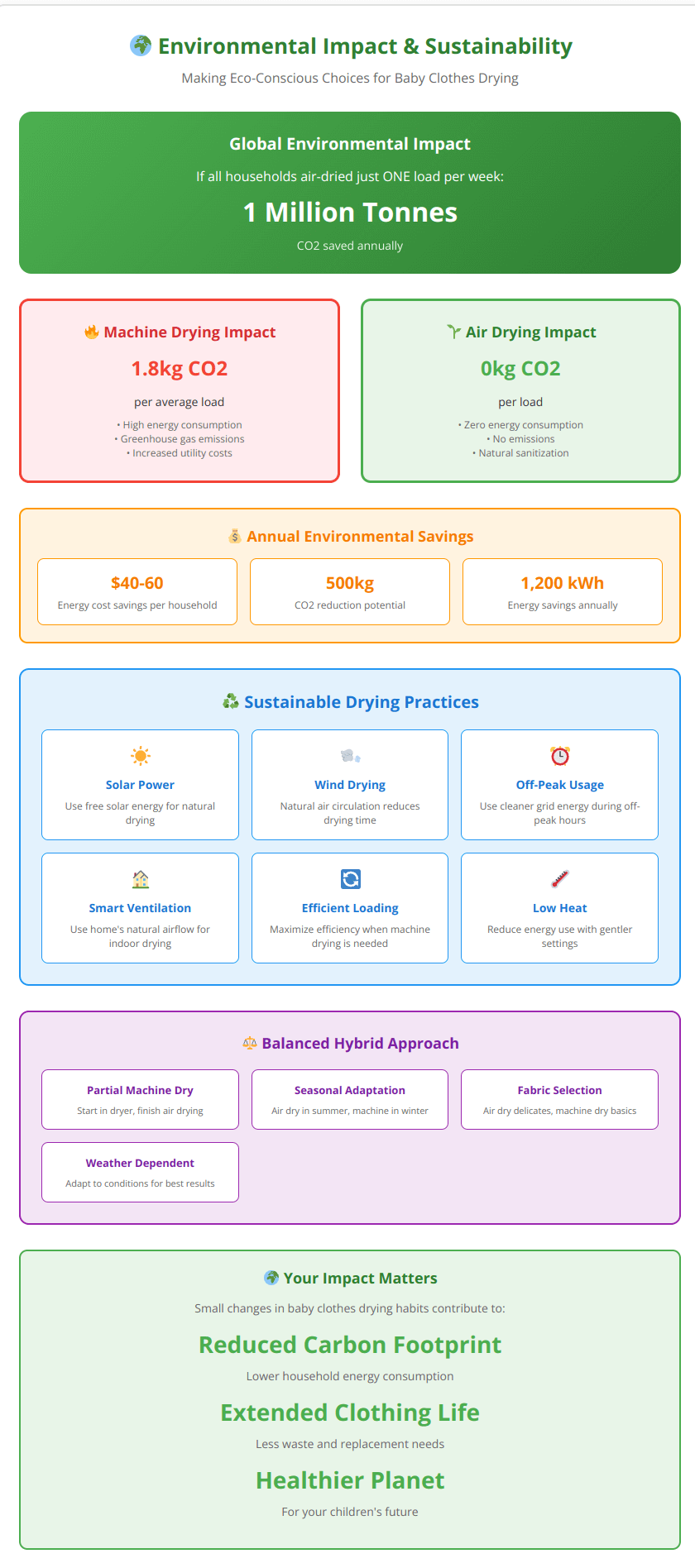
Small changes in drying habits collectively contribute to significant environmental benefits for future generations.
Carbon Footprint Considerations
Traditional electric dryers contribute significantly to household energy consumption. If all households with tumble dryers air-dried just one load per week instead of machine drying, the collective impact would save over a million tonnes of CO2 annually.
Environmental Benefits of Air Drying:
- Zero electricity consumption
- Reduced strain on power grids during peak hours
- Extended appliance lifespan through reduced use
- Lower overall household carbon footprint
When Machine Drying Makes Sense:
- Time-sensitive situations with limited clothing
- Indoor air quality concerns during humid weather
- Safety considerations in areas where outdoor drying isn’t secure
- Accessibility issues that make hanging clothes difficult
Sustainable Drying Practices
Hybrid Approach:
- Air dry most loads when weather permits
- Use dryer for emergency situations or heavy items
- Partially machine dry, then finish air drying to reduce energy use
- Prioritize line drying for items that benefit most (whites in sunlight)
Efficiency Maximization:
- Clean dryer vents annually for optimal performance
- Use moisture sensors to prevent over-drying
- Dry consecutive loads to utilize residual heat
- Choose ENERGY STAR certified appliances when replacing equipment
Modern Parent Insights and Real-World Experiences
Real parent experiences reveal the practical realities of caring for baby clothes in busy family life
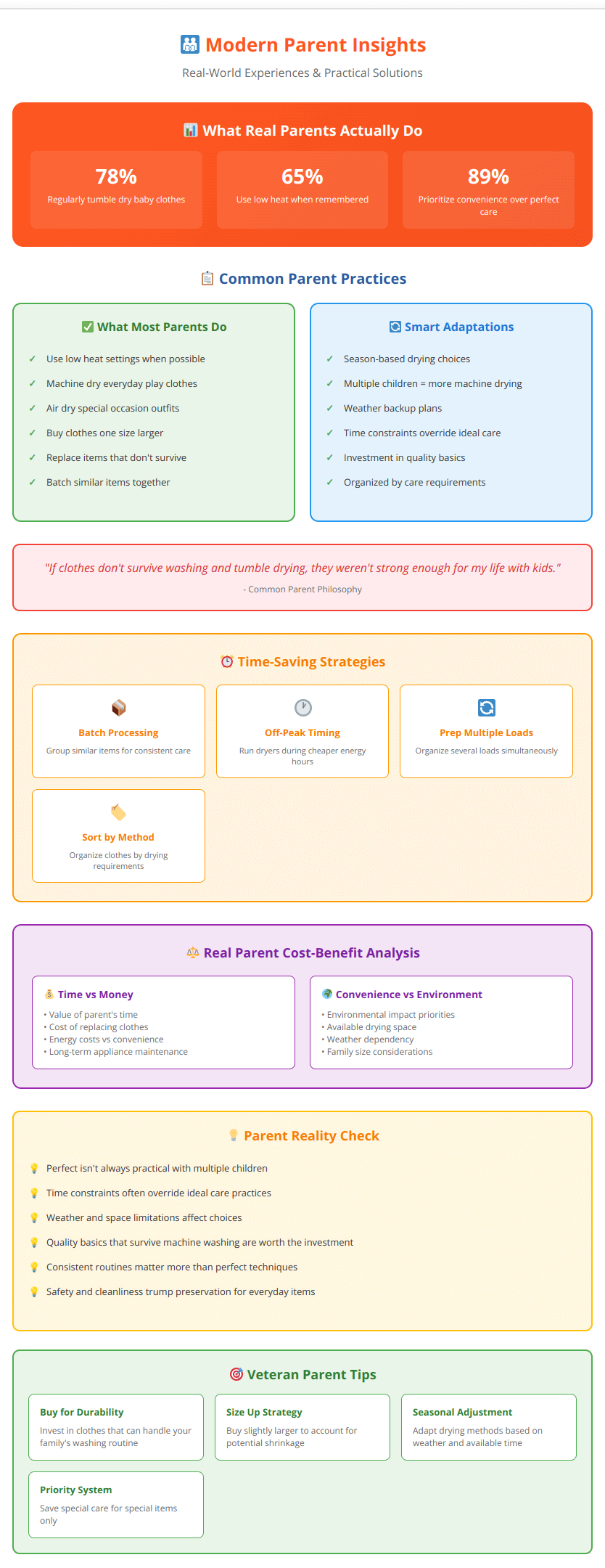
Understanding common parent strategies helps new families develop realistic and sustainable laundry routines.
Survey Insights
Recent parent surveys reveal that most families tumble dry baby clothes despite cautionary labels, prioritizing convenience over perfect preservation. Key findings include:
Common Practices:
- 78% of parents regularly tumble dry baby clothes
- Most use low heat settings when remembered
- Time constraints often override ideal care practices
- Parents with multiple children rely more heavily on machine drying
Practical Adaptations:
- Many parents buy clothes one size larger to account for shrinkage
- “Survival of the fittest” approach – clothes that can’t handle normal care get replaced
- Investment in higher-quality items that withstand frequent washing and drying
- Seasonal adjustments based on weather and available drying space
Time-Saving Strategies
Efficient Routines:
- Batch similar items together for consistent care requirements
- Use programmable dryers to start cycles during off-peak energy hours
- Prep multiple loads simultaneously to maximize efficiency
- Organize clothes by drying method requirements
Cost-Benefit Analysis: While gentle care extends clothing life, the time investment may not be practical for all families. Consider:
- Value of time versus cost of replacing clothes
- Energy costs versus convenience benefits
- Long-term appliance maintenance savings
- Environmental impact priorities
Technical Specifications and Modern Features
Understanding modern dryer technology helps parents make informed decisions about equipment and settings.
Modern dryer technology offers advanced features specifically designed to protect delicate baby clothing.
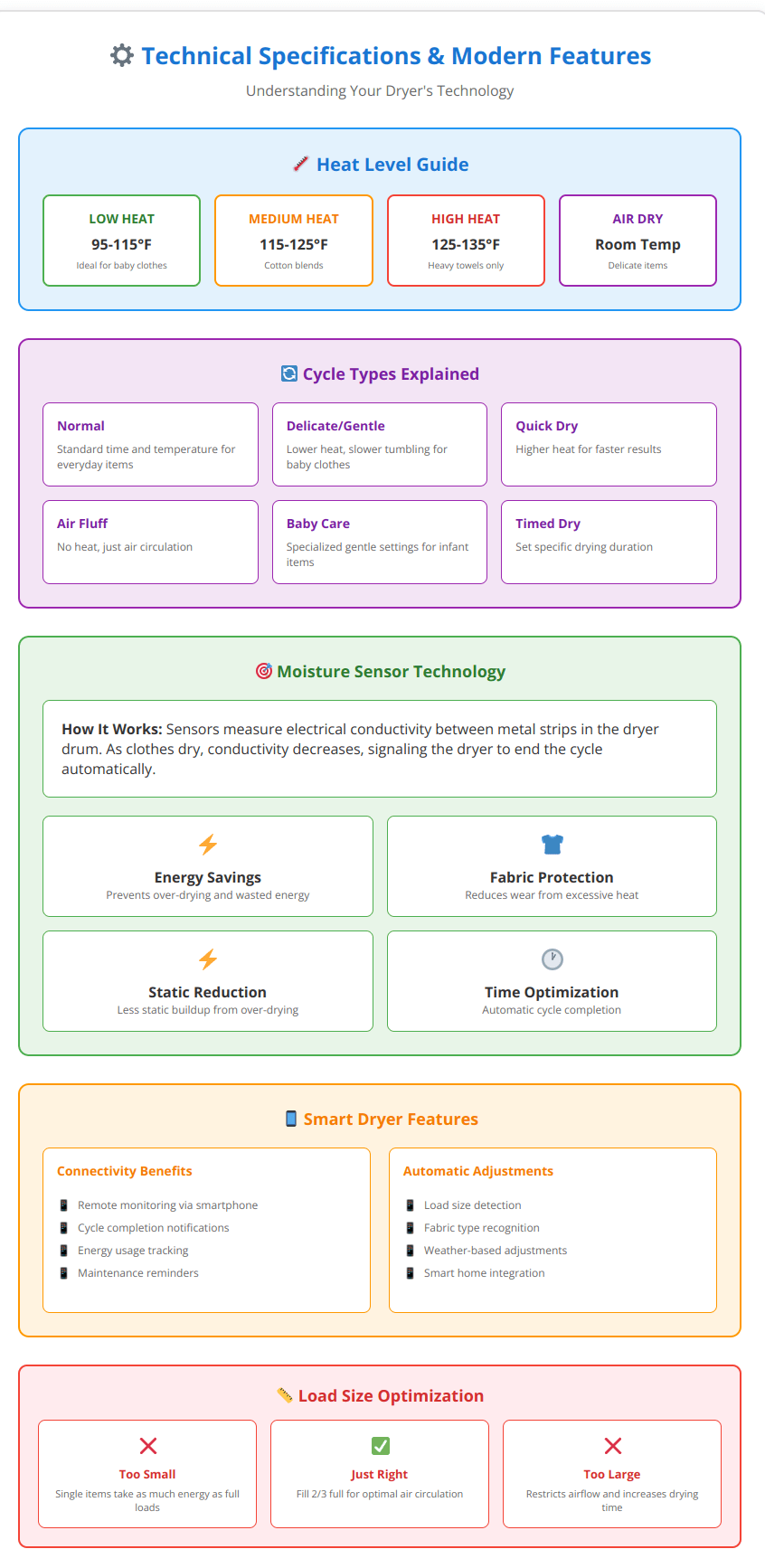
Understanding these technical options helps parents choose equipment that best serves their family’s needs.
Dryer Settings Explained
Heat Levels:
- High Heat (Hot): 125-135°F – Best for sturdy cottons and towels
- Medium Heat (Warm): 115-125°F – Suitable for most cotton blends
- Low Heat (Cool): 95-115°F – Ideal for delicate baby clothes
- Air Dry (No Heat): Room temperature – Best for very delicate items
Cycle Types:
- Normal: Standard time and temperature
- Delicate/Gentle: Lower heat, slower tumbling
- Quick Dry: Higher heat for faster results
- Air Fluff: No heat, just air circulation
- Baby Care: Specialized gentle settings for infant items
Moisture Sensor Technology
Modern dryers with moisture sensors automatically detect when clothes reach optimal dryness and stop the cycle. This technology:
- Prevents over-drying that damages fabrics
- Saves energy by avoiding unnecessary drying time
- Reduces static buildup
- Helps maintain clothing quality longer
How It Works: Sensors measure electrical conductivity between metal strips in the dryer drum. As clothes dry, conductivity decreases, signaling the dryer to end the cycle.
Smart Dryer Features
Connectivity Benefits:
- Remote monitoring and control via smartphone apps
- Cycle completion notifications
- Energy usage tracking
- Maintenance reminders
Automatic Adjustments:
- Load size detection for optimal energy use
- Fabric type recognition (in advanced models)
- Weather-based cycle adjustments
- Integration with smart home systems
Seasonal Considerations and Climate Factors
Weather conditions and seasonal changes significantly impact the best approaches for drying baby clothes.
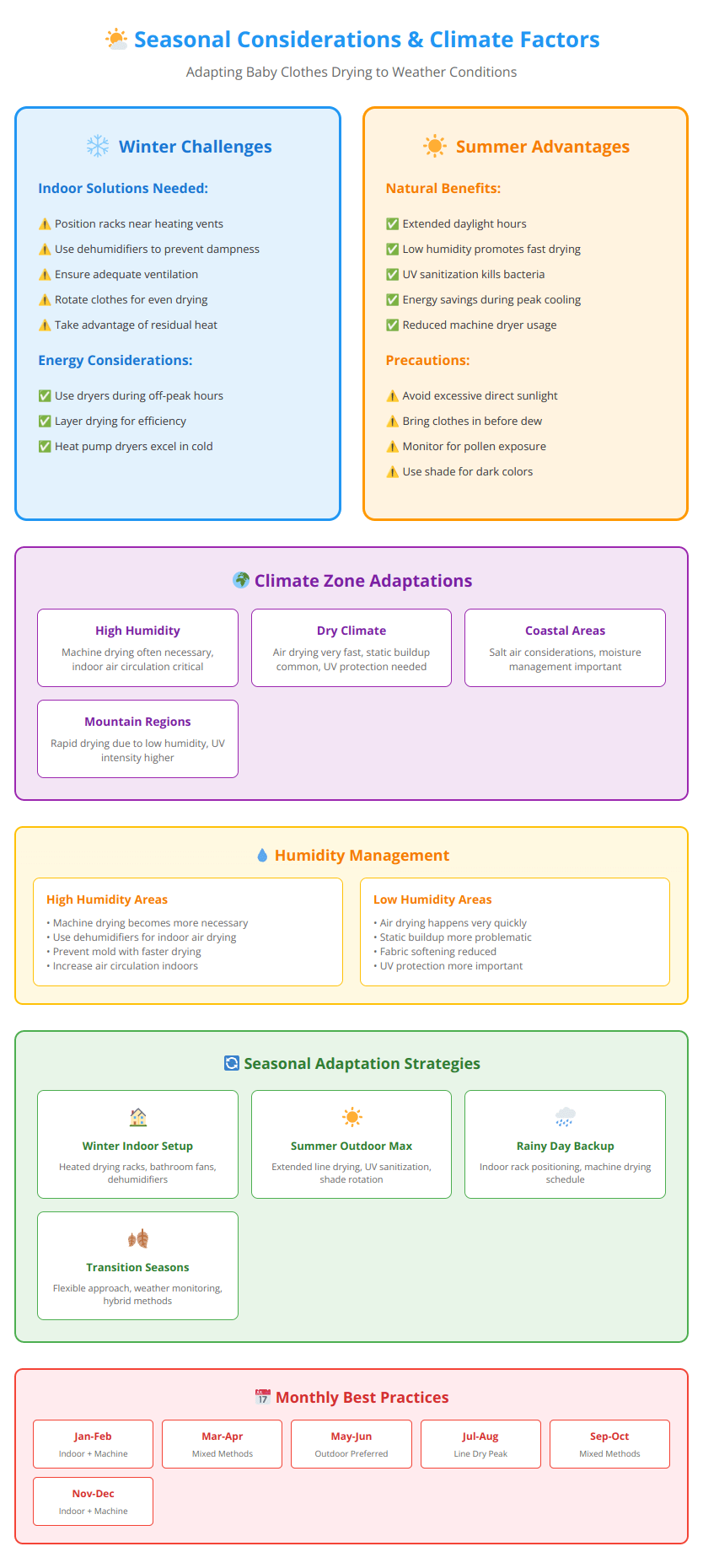
Adapting drying methods to seasonal conditions ensures optimal results year-round regardless of climate.
Winter Drying Challenges
Indoor Solutions:
- Position drying racks near heating vents for faster drying
- Use dehumidifiers to prevent dampness and mold
- Rotate clothes regularly for even drying
- Ensure adequate ventilation to prevent humidity buildup
Energy Considerations:
- Take advantage of residual heat from heating systems
- Use dryers during off-peak hours when possible
- Consider heat pump dryers for maximum efficiency in cold weather
- Layer drying – start machine drying and finish air drying indoors
Summer Advantages
Natural Benefits:
- Extended daylight hours for outdoor drying
- Low humidity promotes faster air drying
- UV sanitization kills bacteria and brightens whites
- Reduced need for machine drying saves energy during peak cooling months
Precautions:
- Avoid excessive direct sunlight that can fade colors
- Bring clothes in before evening dew settles
- Monitor for pollen during high-count days
- Use shade for dark or brightly colored items
Humidity Considerations
High Humidity Areas:
- Machine drying becomes more necessary
- Indoor air circulation becomes critical
- Mold and mildew prevention requires faster drying
- Dehumidifiers can make air drying viable
Dry Climates:
- Air drying happens very quickly
- Static buildup becomes more problematic
- Fabric softening through air drying may be reduced
- UV protection for colors becomes more important
Product Recommendations and Equipment Guide
Choosing the right equipment and accessories can significantly improve baby clothes drying results.
🛒 Recommended Products for Baby Clothes Drying
Expert-curated tools and accessories for safe, efficient baby clothes care
🧶 Best Dryer Balls for Baby Clothes

Smart Sheep 6-Pack XL Wool Dryer Balls
100% premium New Zealand wool dryer balls that naturally soften clothes and reduce drying time by up to 25%.
- Reduces drying time and energy costs
- Chemical-free fabric softening
- Reduces static and wrinkles
- Lasts over 1000 loads
- Hypoallergenic and baby-safe

Friendsheep Organic Wool Dryer Balls (6 Pack)
Organic, eco-friendly wool dryer balls made from premium merino wool with adorable designs that kids love.
- GOTS certified organic wool
- Handmade by women cooperatives
- Fun colors and designs
- Plastic-free packaging
- Perfect for sensitive skin
🏠 Top-Rated Drying Racks

Whitmor Spacemaker Drying Rack
Sturdy, space-saving drying rack with 14 linear feet of drying space. Perfect for apartments and small spaces.
- 14 linear feet of drying space
- Folds flat for easy storage
- Rust-resistant steel construction
- Indoor/outdoor use
- Holds up to 30 lbs of wet clothes

Honey-Can-Do Collapsible Mesh Drying Rack
Collapsible 3-tier mesh drying rack ideal for delicate baby clothes, sweaters, and flat-drying items.
- 3 spacious mesh shelves
- Collapsible design saves space
- Perfect for flat-drying
- Breathable mesh promotes airflow
- Lightweight and portable
⚡ Energy-Efficient Dryers

LG 4.2 Cu.Ft. Smart Wi-Fi Enabled Heat Pump Dryer
ENERGY STAR certified heat pump dryer that uses 60% less energy while providing gentle, effective drying.
- ENERGY STAR Most Efficient
- 60% more energy efficient
- Ventless installation
- 14 preset drying cycles
- ThinQ app connectivity
🧽 Baby-Safe Stain Removers

Dreft Stage 1: Newborn Baby Liquid Laundry Detergent
Pediatrician-recommended detergent specially formulated for newborn clothes with hypoallergenic formula.
- Pediatrician recommended
- Hypoallergenic formula
- Works on formula, food, and diaper stains
- Safe for baby’s sensitive skin
- No harsh chemicals or dyes
📊 Quick Comparison Guide
| Product Type | Best For | Price Range | Key Benefit |
|---|---|---|---|
| Wool Dryer Balls | All baby clothes | $15-25 | Chemical-free softening |
| Folding Drying Rack | Everyday air drying | $25-40 | Space-efficient storage |
| Mesh Drying Tower | Delicate flat-dry items | $20-30 | Proper wool/sweater care |
| Heat Pump Dryer | Energy-conscious families | $1,200-2,500 | 60%+ energy savings |
| Baby Detergent | Gentle cleaning | $4-8 | Safe, effective cleaning |
Best Dryer Balls and Accessories
Wool Dryer Balls:
- 100% natural wool reduces drying time by up to 25%
- Naturally softens fabrics without chemicals
- Reduces static buildup
- Can be used with a drop of baby-safe essential oil for scent
Alternative Options:
- Rubber dryer balls for synthetic fabrics
- Dryer sachets with natural lavender for gentle scent
- Tennis balls (clean, designated for laundry only)
Energy-Efficient Dryer Models
Top Recommendations for Baby Laundry:
- Models with multiple low-heat settings
- Moisture sensors for automatic shut-off
- Gentle/baby-specific cycles
- Energy Star certification
- Adequate capacity for family needs without over-sizing
Heat Pump Dryers: While more expensive initially, heat pump models offer:
- 60-70% energy savings over conventional dryers
- Gentler drying temperatures
- No external venting required
- Better for apartment living
Drying Rack Solutions
Indoor Options:
- Expandable racks that fit in small spaces
- Over-door hanging systems
- Ceiling-mounted retractable lines
- Heated drying racks for faster indoor drying
Outdoor Considerations:
- Retractable clotheslines for flexible use
- Umbrella-style rotary dryers for maximum capacity
- Folding racks for portable outdoor use
- Weather-resistant materials for durability
Troubleshooting Common Issues
Even with careful attention, common problems can arise when drying baby clothes that require quick solutions.
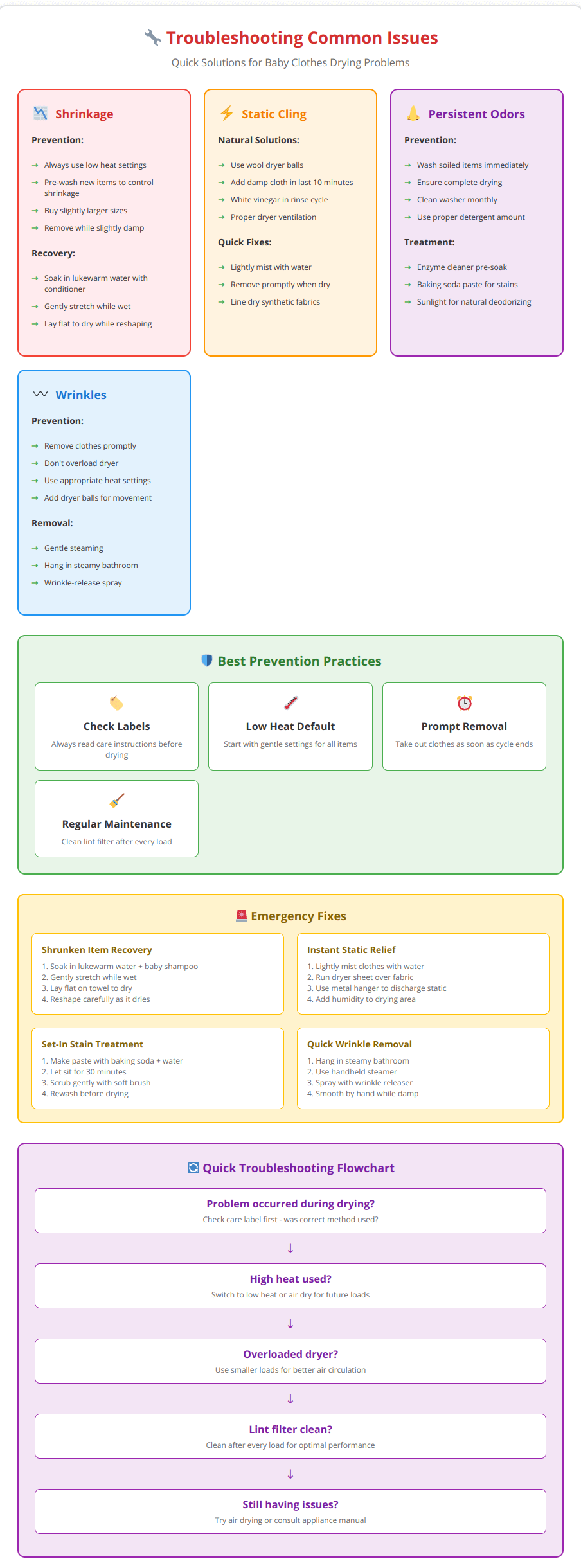
Having these troubleshooting strategies ready helps parents address issues before they become permanent problems.
Shrinkage Prevention and Recovery
Prevention Strategies:
- Always check care labels before first wash
- Pre-wash and air dry new items to control initial shrinkage
- Use cold water washing when possible
- Avoid high heat drying settings
- Remove items while slightly damp
Recovery Techniques: If shrinkage occurs:
- Soak in lukewarm water with hair conditioner for 30 minutes
- Gently stretch fabric while wet
- Lay flat to dry while reshaping
- Use fabric relaxer products designed for shrinkage
- Steam gently to relax fibers
Static Cling Solutions
Natural Remedies:
- Wool dryer balls provide mechanical action to reduce static
- Slightly dampen a clean cloth and add to dryer for last 10 minutes
- Line dry synthetic fabrics that tend to create static
- Use white vinegar in rinse cycle as natural fabric softener
Equipment Solutions:
- Ensure proper dryer ventilation
- Clean lint filter thoroughly after each load
- Check dryer ductwork for blockages
- Consider anti-static dryer sheets for severe cases (use sparingly)
Persistent Odor Issues
Odor Prevention:
- Ensure clothes are completely dry before storing
- Wash soiled items promptly to prevent odor setting
- Use appropriate amount of detergent (too little leaves residue, too much creates buildup)
- Clean washer monthly to prevent mildew transfer
Natural Odor Solutions:
- Add 1/2 cup white vinegar to rinse cycle for natural deodorizing
- Soak heavily soiled items in enzyme cleaner before washing
- Air dry in sunlight when possible for natural sanitization
- Use baking soda paste for stubborn stain and odor combination
Wrinkle Prevention
During Drying:
- Remove clothes promptly when dry
- Use appropriate heat settings (over-drying increases wrinkles)
- Avoid overloading dryer for proper air circulation
- Add wool dryer balls to keep clothes moving
Post-Drying Care:
- Fold or hang immediately after drying
- Use gentle steaming for delicate wrinkled items
- Store properly to prevent compression wrinkles
- Consider wrinkle-release sprays for quick touch-ups
Conclusion
Drying baby clothes safely requires balancing convenience, fabric care, energy efficiency, and safety considerations. Most baby clothes can be tumble dried successfully when parents use appropriate settings and follow care label instructions.
Key Takeaways for Parents
- Safety First: Always prioritize safety by understanding flame retardant requirements for sleepwear and avoiding chemical additives like dryer sheets that can irritate sensitive baby skin or compromise safety treatments.
- Fabric-Specific Care: Different materials require different approaches. Cotton can typically handle low heat drying, while delicate fabrics like wool and heavily embellished items need air drying for best results.
- Energy and Environmental Awareness: Consider the environmental impact of drying choices. Air drying when possible saves energy and money while providing natural sanitization benefits through sunlight exposure.
- Practical Balance: Real-world parenting often requires compromise between ideal care practices and time constraints. Buying quality items that can withstand regular machine drying, sizing up to account for potential shrinkage, and prioritizing which items receive special care helps create sustainable routines.
Essential Best Practices
- Always check care labels before drying any baby clothes
- Use low heat settings as the default for machine drying
- Clean lint filters after every load for safety and efficiency
- Invest in wool dryer balls as a natural alternative to chemical dryer sheets
- Air dry when possible for gentlest care and energy savings
- Address stains immediately before heat setting makes them permanent
- Consider the total cost including energy, replacement clothes, and time when choosing drying methods
Recommendations by Priority
High Priority (Safety and Health):
- Understand flame retardant requirements for sleepwear
- Avoid chemical dryer sheets and fabric softeners
- Use only baby-safe laundry products
- Ensure all clothes are completely dry before storing
Medium Priority (Quality and Longevity):
- Use appropriate heat settings for different fabric types
- Turn embellished items inside out for protection
- Remove clothes promptly when drying cycle ends
- Invest in quality drying equipment like moisture sensors
Lower Priority (Optimization):
- Time drying cycles during off-peak energy hours
- Use ENERGY STAR certified appliances when replacing equipment
- Implement seasonal drying strategies based on weather
- Track energy usage to optimize household efficiency
Looking Forward
As children grow and clothing needs change, drying practices can evolve too. Toddler clothes often prove more durable and forgiving than newborn items, allowing for more flexibility in care routines. However, maintaining good habits established during the baby years helps preserve clothing quality and ensures safe practices continue.
The most successful approach combines understanding of fabric care principles with practical adaptation to individual family circumstances. Whether choosing convenience or conservation, the key lies in making informed decisions that work for each family’s unique situation while keeping baby’s comfort and safety as the top priority.
Remember that perfect isn’t always practical, and finding a sustainable routine that works for your family is more valuable than following every ideal recommendation. The goal is healthy, comfortable babies wearing clean, well-maintained clothes, achieved through whatever combination of methods works best for your household.

